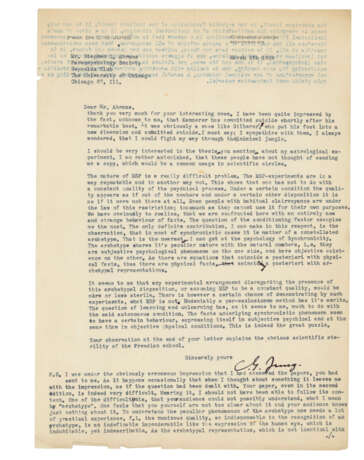ID 1109098
Lot 297 | Carl Jung (1875-1961)
Estimate value
£ 5 000 – 8 000
Typed letter signed (‘C.G. Jung’) to Stephen Abrams, [Küsnacht], 5 March 1959
In English. 1.5 pages, 295 x 209mm, headed letter-paper, scattered ink corrections. Provenance: Stephen I Abrams (1938-2012) – Sotheby's, 29 & 30 April 1980, lot 288.
On the suicide of Paul Kammerer, experiments in extra-sensory perception, a true understanding of archetypes and the ‘scientific sterility’ of the Freudian school. Jung was moved by the death of Kammerer, who ‘committed suicide shortly after his remarkable book. It was obviously a case like Silberer's, who put his foot into a new dimension and committed suicide. I must say: I sympathise with them. I always wondered, that I could fight my way through the inimical jungle’. Turning to ESP, Jung outlines some of the difficulties of conducting experiments in the field: ‘Under a certain condition the quality appears as if out of the nowhere and under a certain other disposition it is as if it were not there at all. Even people with habitual clairvoyance are under the law of this restriction; inasmuch as they cannot use it for their own purposes. We have obviously to realise, that we are confronted here with an entirely new and strange behaviour of facts. The question of the conditioning factor occupies me the most. The only definite contribution, I can make in this respect, is the observation, that in most of synchronistic cases it is [a] matter of a constellated archetype. That is the nearest I can get at the psychology of Synchronicity. The archetype shares it’s [sic] peculiar nature with the natural numbers’, i.e. they have both subjective and objective dimensions – ‘It seems to me that any experimental arrangement disregarding the presence of this archetypal disposition, or assuming ESP to be a constant quality, would be more or less sterile’. Jung adds an important post-script, a critique of a paper Abrams has sent him, setting out once again his definition of the archetype and the practical experience needed to understand his concept.
Paul Kammerer had committed suicide some years earlier, in 1926, after the publication of his Die Vererbung erworbener Eigenschaften, when it was discovered that one of his assistants had been fabricating experimental results; the ‘remarkable book’ to which Jung refers was Das Gesetz der Serie, which contained a discussion of synchronicity. Jung’s correspondence with Abrams on this topic began in 1957, when Abrams was studying under J.B. Rhine (see three preceding lots) and is notable for its expositional quality and the complexity of the ideas contained therein.
| Artist: | Carl Gustav Jung (1875 - 1961) |
|---|---|
| Place of origin: | Switzerland |
| Artist: | Carl Gustav Jung (1875 - 1961) |
|---|---|
| Place of origin: | Switzerland |
| Address of auction |
CHRISTIE'S 8 King Street, St. James's SW1Y 6QT London United Kingdom | |||||
|---|---|---|---|---|---|---|
| Preview |
| |||||
| Phone | +44 (0)20 7839 9060 | |||||
| Buyer Premium | see on Website | |||||
| Conditions of purchase | Conditions of purchase |












